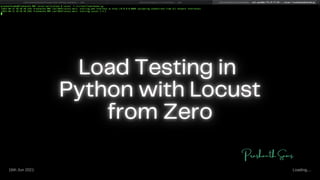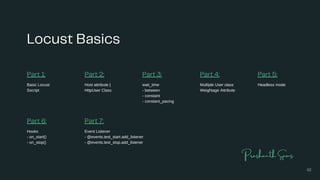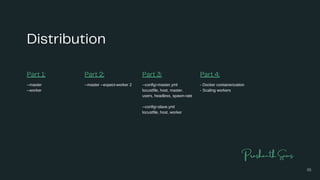Load Testing in Python with Locust from Zero
- 2. Locust Basics Part 1: Basic Locust Sscript Part 2: Host attribute | HttpUser Class Part 3: wait_time - between - constant - constant_pacing Part 4: Multiple User class Weightage Attribute Part 5: Headless mode 02 Part 6: Hooks - on_start() - on_stop() Part 7: Event Listener - @events.test_start.add_listener - @events.test_stop.add_listener Prashanth Sams
- 3. Tasks Part 1: Task weightage - @task(2) Part 2: Task attribute tasks = [a, b] Task Weightage tasks ={a:2, b:1} Part 3: @task inside TaskSet Part 4: SequentialTaskSet Part 5: Nested TaskSet - SequentialTaskSet - Task Weightage - self.interrupt() 03 Prashanth Sams
- 4. Http Requests Part 1: GET Request - self.client.get('/', name='A') Part 2: POST Request - self.client.post('/', data='', headers='', name='', catch_response=True) Part 3: - response.success() - response.failure(exc='') Part 4: Cookies - .cookies[''] - self.client.cookies.clear() Part 5: @tag('') 04 Prashanth Sams
- 5. Distribution Part 1: --master --worker Part 2: --master --expect-worker 2 Part 3: --config=master.yml locustfile, host, master, users, headless, spawn-rate --config=slave.yml locustfile, host, worker 05 Prashanth Sams Part 4: - Docker containerization - Scaling workers



![Tasks
Part 1:
Task weightage
- @task(2)
Part 2:
Task attribute
tasks = [a, b]
Task Weightage
tasks ={a:2, b:1}
Part 3:
@task inside TaskSet
Part 4:
SequentialTaskSet
Part 5:
Nested TaskSet
- SequentialTaskSet
- Task Weightage
- self.interrupt()
03
Prashanth Sams](https://image.slidesharecdn.com/greendarkprofessionalgovernmentprogressreportsustainabledevelopmentgoalspresentation1-210616203606/85/Load-Testing-in-Python-with-Locust-from-Zero-3-320.jpg)
![Http Requests
Part 1:
GET Request
- self.client.get('/', name='A')
Part 2:
POST Request
- self.client.post('/', data='',
headers='', name='',
catch_response=True)
Part 3:
- response.success()
- response.failure(exc='')
Part 4:
Cookies
- .cookies['']
- self.client.cookies.clear()
Part 5:
@tag('')
04
Prashanth Sams](https://image.slidesharecdn.com/greendarkprofessionalgovernmentprogressreportsustainabledevelopmentgoalspresentation1-210616203606/85/Load-Testing-in-Python-with-Locust-from-Zero-4-320.jpg)

